From the pages of
Sublette Examiner
Volume 2, Number 20 - August 15, 2002
brought to you online by Pinedale Online
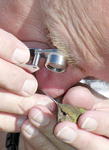
A couple of weeks ago, licensed hummingbird bander Dave Patton from Lafayette, La., visited Pinedale to collect information about the hummingbirds traveling through Wyoming as they migrate across North America. Here, Patton checks the beak for markings to indicate age of the bird. |
Eye To Eye
Tiny Tails to Tell
by Delsa AllenAll of us in Sublette County see hummingbirds from time to time during summer months. Most of us even have a feeder or two around our houses. We may not know much about them, but enjoy watching and listening to them buzz around, especially during prime feeding times: early morning and in the evening when energy consumption is the most important. They'll arrive in mid-May and leave in the early part of September.
A couple of weeks ago, licensed hummingbird bander Dave Patton from Lafayette, La., visited Pinedale to collect information about the hummingbirds traveling through Wyoming as they migrate across North America.
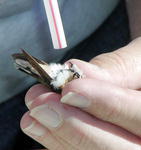
Not all of Dave's tools are specialized. A household straw is used to check the amount of fat the hummingbird has. "It's the safest way to move the feathers out of the way," Dave said. |
Dave had done some banding in the Big Piney area in years past, but according to him, the location just wasn't working out the best; he wasn't seeing the number of birds he was wanting to. After visiting with a number of people in the county, one person's name, more than any other, kept coming up in conversations: Barb Wise, the "bird lady." It wasn't long after that contact was made and arrangements were set for him to pay her a visit. After seeing the set-up Barb had for the little hummers, Dave knew her yard would work out great for a "banding station."
In the three days spent at Barb's, 95 hummingbirds were caught, with only three being repeat clients.
During last year's visit with Dave, Barb also suggested another location: Jim and JJ Huntley's. Once done at Barb's this year, Dave then spent a couple of afternoons at the Huntley residence, where he banded 45 more.
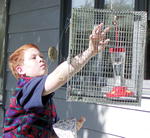
Dru Pflughoft, along with his brother, Kit, helps capture hummingbirds for Dave. The cages Dave has made are totally safe. The doors are made of soft mesh that won't damage the bird if the door shut on the bird. The doors are attached to fishing line that's used to release the doors once a hummingbird is lured into the cage. From there, the bird is gently placed into a soft bag and taken to Dave. With the help of others to do this, it saves Dave lots of time and allows him to see more birds in one day. Saturday, Kelsi and Casey Dean assisted Dave, with Casey even helping him collect data. |
There are very few banders in the western states; Dave being the only one in Wyoming.
Data that is collected from banders around the world is then sent to an organization that handles the information and keeps track of all banded hummingbirds.
According to Dave, there are times when a bander captures a bird somewhere and collects information about that bird, and months later another bander may get information on the same one hundreds of miles away. General information can be collected to give researchers a better idea of migratorial and behavorial patterns of many different species of hummingbirds around the world.
There are four species common to Sublette County: the Rufous, Broad-tailed, Calliope and Black-chinned hummingbirds, with most of them being the Rufous.
If you ever wonder about the number of hummingbirds you might have around your yard, Dave suggests to multiply the number of birds you have at your feeder by five.
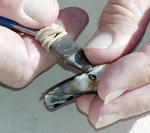 |
The most important step: placing the bands on those little legs is a delicate job. The bands are the same size as a small bead and must be put on just right so as not to cause irritation to the bird. |
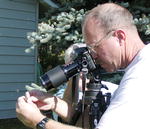 |
Sometimes Dave will find a unique pattern or some distinct feather shape he has not seen before or rarely sees, so he will photograph it. Most of the time he doesn't have enough hands to get the job done himself, so Barb gladly steps in to press the shutter when Dave is ready. |
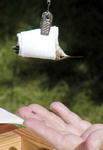 |
To weigh the birds, they are first wrapped in a soft cloth then placed on a scale. At Barb's, the battery failed and Dave had to use a hanging scale, where the birds are placed upside down, which most didn't seem to mind at all. The smallest one Dave weighed came in at 2.1 grams and the largest weighed a whopping 5 grams. |
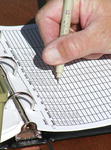 |
A number of data points are collected for each hummingbird, including essentials like band number and species. Dave also writes down information about sex, age, weight, fat percentage and more information that will help determine the bird's overall health. |
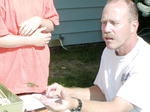 |
Once Dave's patients are finished with their exam, they are glad to leave his hand. The whole process takes about five minutes. |
Photo credits: Delsa Allen
See The Archives for past articles.
Copyright © 2002 Sublette Examiner
All rights reserved. Reproduction by any means must have permission of the Publisher.
Sublette Examiner, PO Box 1539, Pinedale, WY 82941 Phone 307-367-3203
examiner@wyoming.com
|







